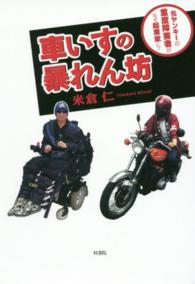Full Description
Elementary Children's Literature,4e by Nancy A. Anderson, gives pre-service teachers of elementary, early childhood, and special education students-plus media specialists and parents of children aged infancy through 13-a comprehensive look at children's literature in general plus information about hundreds of today's best books in children's literature. Organized around genres; written in a conversational tone; and packed with teaching strategies, technology applications, authoritative coverage of multicultural literature, and many instructional tie-ins, the book helps teachers and parents apply their knowledge of literature to help children grow in their language and reading abilities.
Contents
Part One1. Introduction to the World of Children's LiteratureDefining Literature for ChildrenThe Birth of Modern Children's LiteratureBook IllustrationsThe Genres of LiteratureThe Dewey Decimal SystemBook FormatsThe Value of Children's LiteraturePrereading Schema BuildingSummary2. Elements of Quality Children's LiteratureBook AwardsLiterary ElementsResponding to LiteratureReader Response Theory by Gloria HoustonLiterature CirclesDeveloping a Classroom Library by Susan E. KnellSummary3. The Art of IllustrationEvaluating IllustrationsThe Union of Art and TextVisual Elements of Artistic DesignArtistic StylesArtistic Media and TechniquesIntegrating Visual Art and Literature by Janet C. RichardsSummary4. Early Childhood BooksBooks of Early ChildhoodMotivating Children to Become Lifelong Readers by Susan E. KnellSummary5. Traditional LiteratureEvaluating Traditional LiteratureHistoryCharacteristicsThemes of Traditional LiteratureThe Subgenres of Traditional LiteratureSummaryPart Two: The Boundless World of Fiction6. Modern FantasyEvaluating Modern FantasyThe Beginnings of Fiction and Modern FantasyTypes of FantasySummary7. Animal FantasyEvaluating Animal FantasyMilestones in Animal FantasyTypes of Animal FantasySummary8. Culturally Diverse LiteratureEvaluating Culturally Diverse LiteratureCategories of Culturally Diverse BooksMisrepresentation of CultureLatino Literature by Alcione N. OstorgaAfrican American Literature by Sabrina A. BrinsonAsian American Literature by Ni ChangNative American LiteratureLiterature of Religious CulturesSummary9. Contemporary Realistic FictionEvaluating Contemporary FictionCharacteristics of Contemporary Realistic FictionThemesBibliotherapy by Dan T. Ouzts and Mark J. PalomboFamiliesFriendshipHumorAdventureMysterySocial RealityPersonal IssuesAnimalsCensorship by Jenifer Jasinsky Schneider 10. Historical FictionEvaluating Historical FictionCharacteristics of Historical FictionBiographic Historical FictionResearching Historical FictionScott O'Dell AwardPeriods Depicted in Historical FictionEnhancing Curriculum with Historical Fiction by Sharon SmithSummaryPart Three: Discovering the World through Nonfiction11. Biography and AutobiographyEvaluating BiographyReading Biographies for PleasureTypes of BiographyForms of BiographyIntegrating Biography with the Study of HistoryEnhancing Curriculum with Biography by Sharon SmithSummary12. Informational BooksEvaluating Informational BooksCharacteristics of Informational BooksEnhancing Curriculum with Informational BooksBuilding a Foundation for Content Area ReadingGraphic OrganizersSummary13. Poetry and VerseEvaluating Poetry and VerseCharacteristics of Poetry and VerseForms of PoetryPoetry in Our CultureNCTE Award for Excellence in Poetry for ChildrenDeveloping Love (or Hate) for PoetryTypes of Poetry BooksThe Value of Poetry in the Classroom by Georgann C. WyattSummary14. Teaching Reading through LiteratureReading Aloud to ChildrenSustained Silent ReadingReading Instruction with Trade booksChildren's Oral ReadingGuided Silent ReadingImplementing a Yearlong Literature ProgramSummaryGlossaryReferencesName and Title IndexSubject Index







